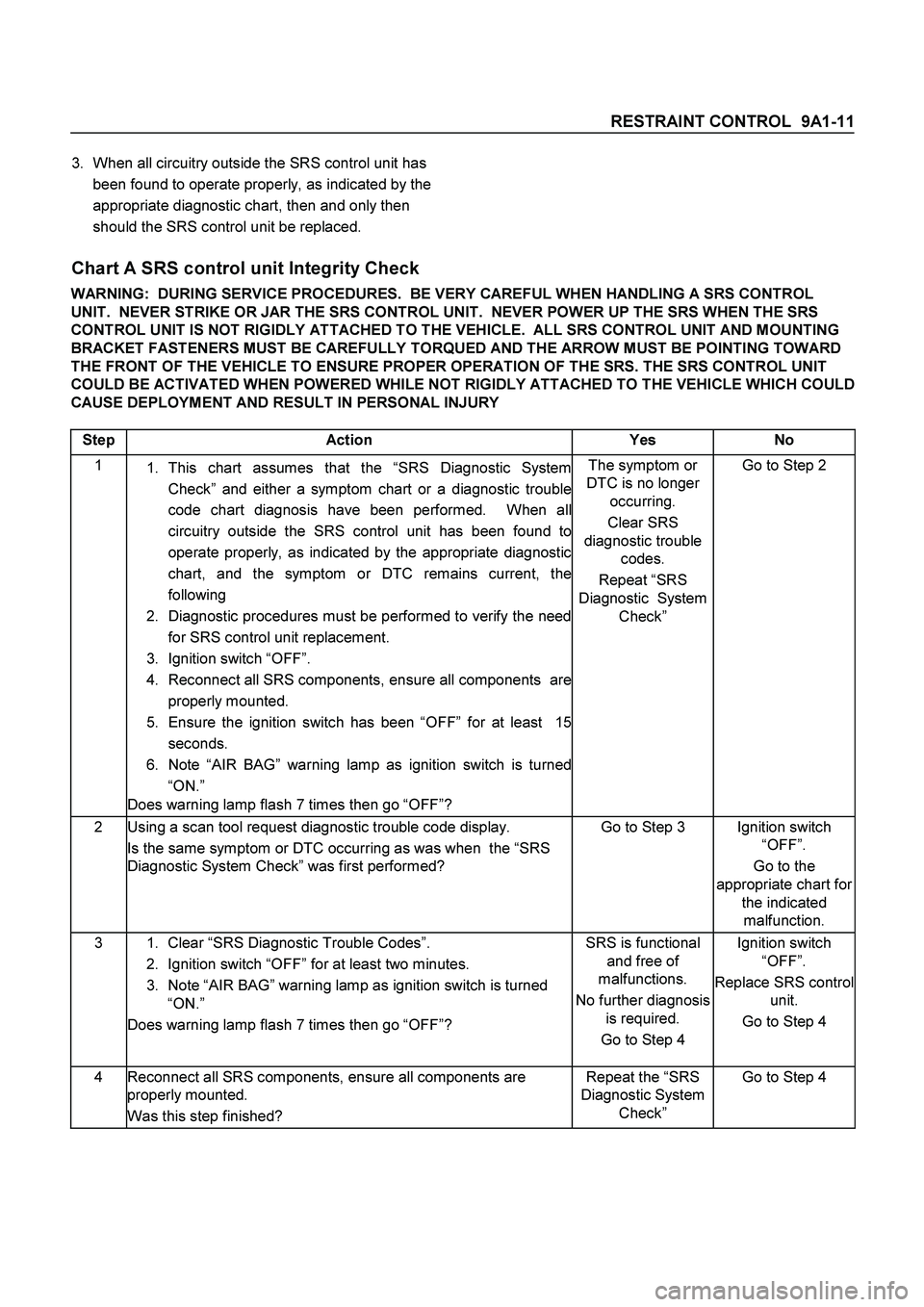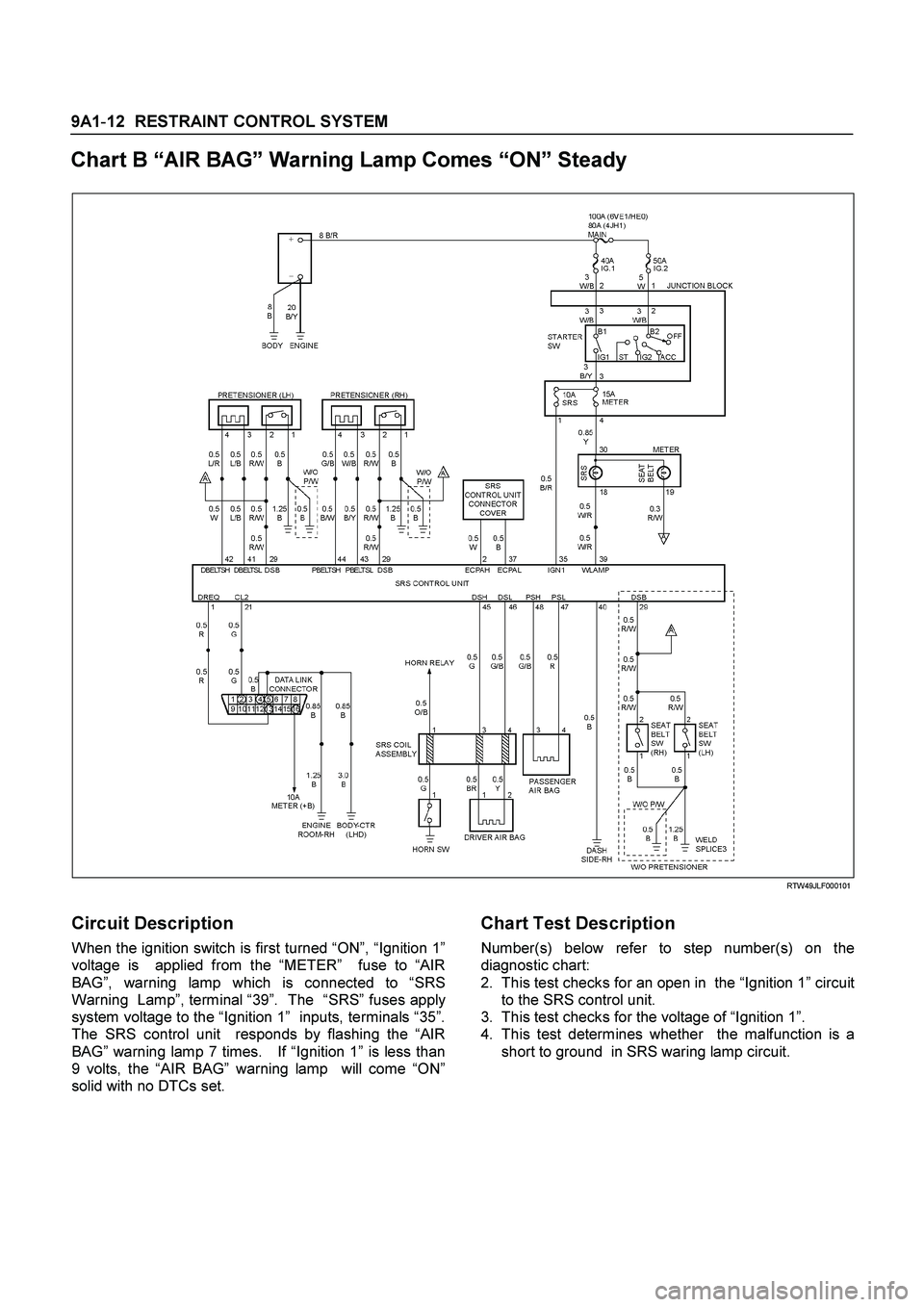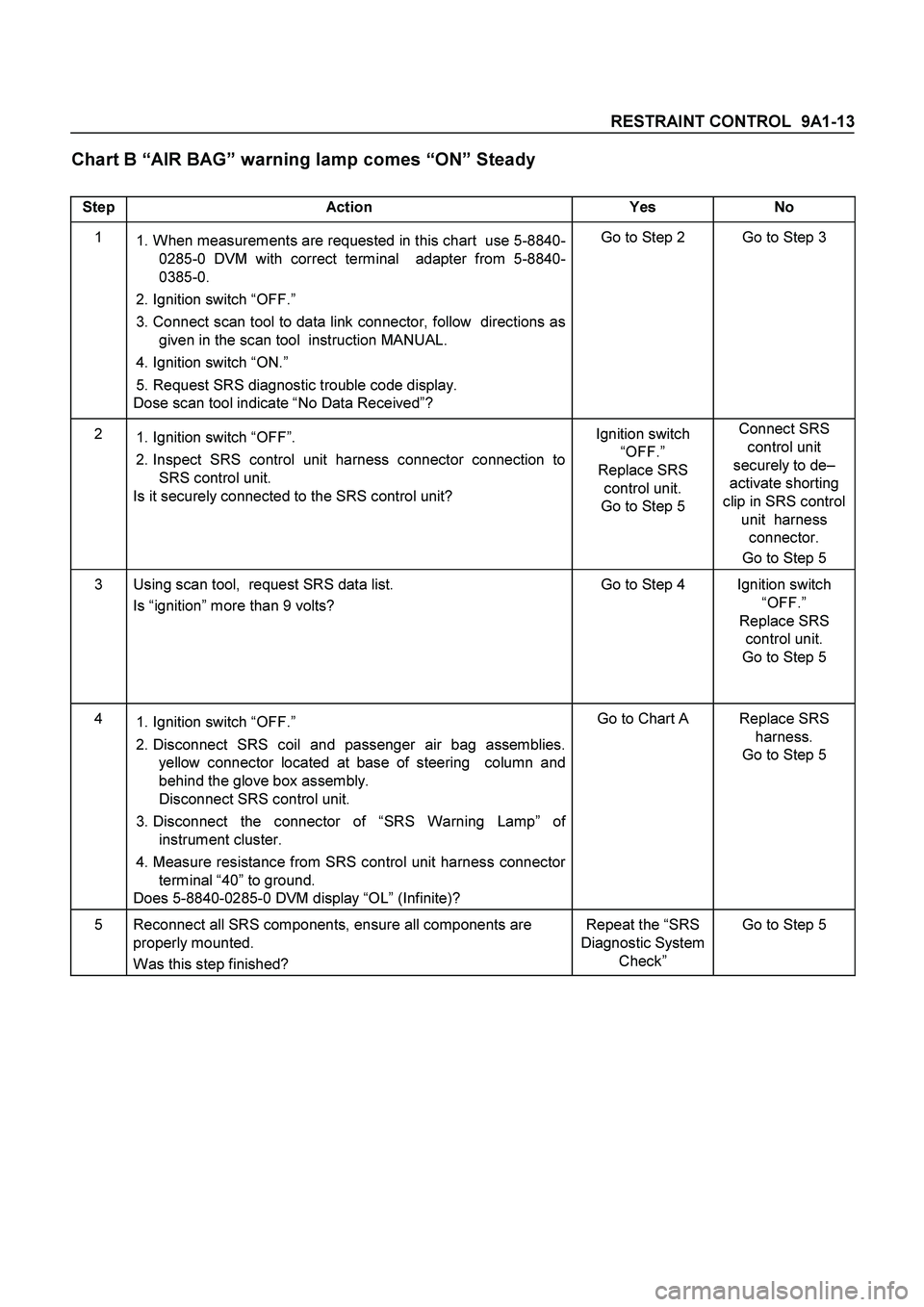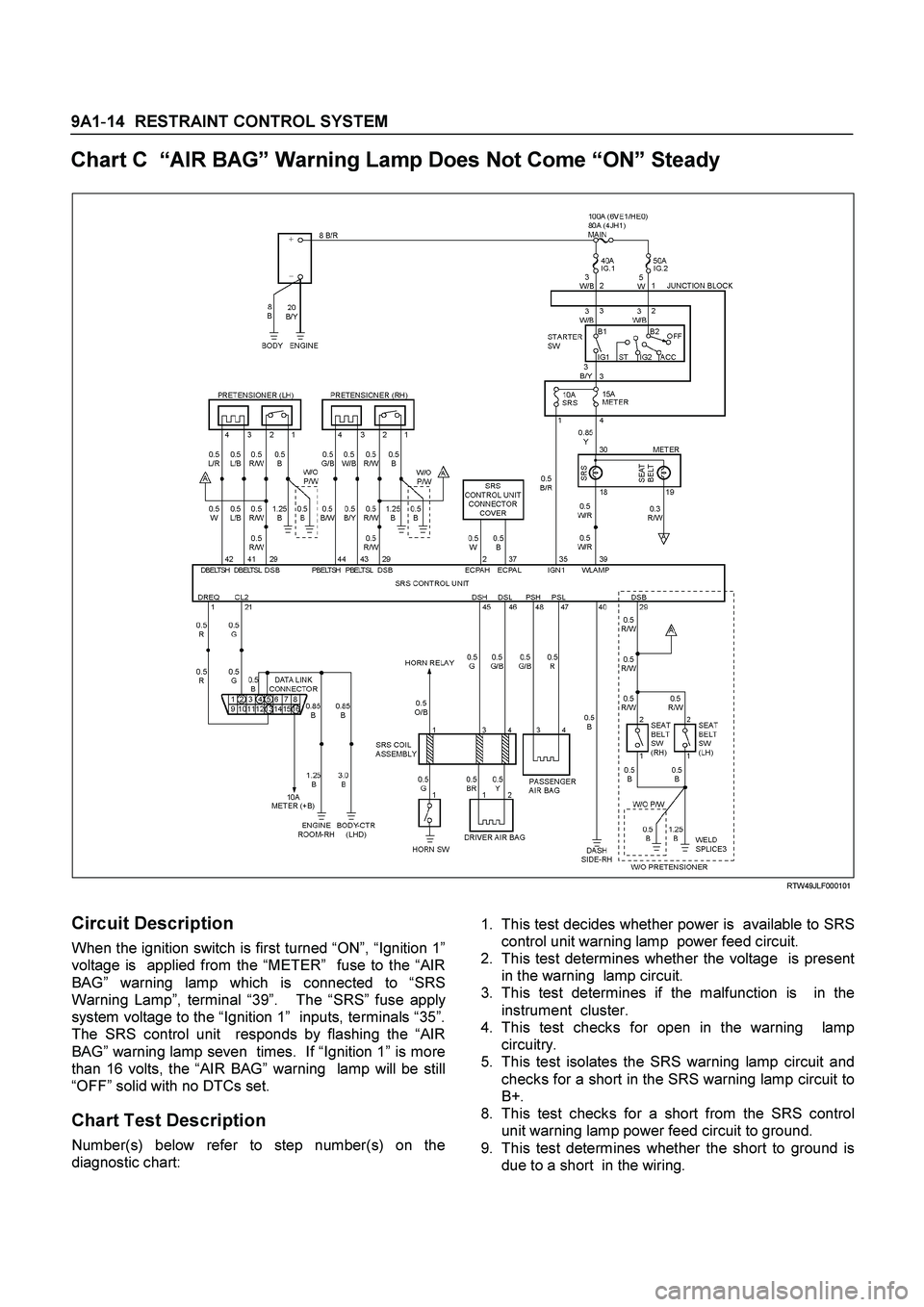2004 ISUZU TF SERIES switch
[x] Cancel search: switchPage 74 of 4264

9A1-4 RESTRAINT CONTROL SYSTEM
cautions in the service manual and on warning labels
attached to SRS components.
Basic Electrical Circuits
You should understand the basic theory of electricity
including series and parallel circuits, and understand
the voltage drops across series resistors. You should
know the meaning of voltage (volts), current (amps),
and resistance (ohms). You should understand what
happens in a circuit with an open or a shorted wire. You
should be able to read and understand a wiring
diagram.
“Flash Code” Diagnostics
Flash code diagnostics can be used to read active
codes and to determine if history codes are present but
cannot be used to clear codes or read history codes.
Flash code diagnostics is enabled by grounding by
terminal 4 shorting to terminal 13 of the DLC connector
with the ignition switch “ON”. Grounding terminal 4 of
the DLC connector pulls the “Diagnostics Request”
input (Terminal 1) of the SRS control unit low and
signals the SRS control unit to enter the flash code
diagnostic display mode.
060R300052
Page 78 of 4264

9A1-8 RESTRAINT CONTROL SYSTEM
Circuit Description
When the ignition switch is first turned “ON”, “Ignition 1”
voltage is applied from the “SRS” fuse to the SRS
control unit at the “Ignition 1” input terminals “35”. The
SRS control unit responds by flashing the “AIR BAG”
warning lamp seven times, while performing tests on
the SRS.
Notes On System Check Chart
1.
The “AIR BAG” warning lamp should flash seven
times after ignition is first turned “ON”.
2.
After the “AIR BAG” warning lamp flashes seven
times, it should turn “OFF”
3.
This test checks for the proper operation of the
“Serial Data” line. This test will also determine
whether history diagnostic trouble codes are stored
and, if so, identify them.
4.
Improper operation of the “AIR BAG” warning lamp
is indicated. This test differentiates a warning lamp
stays “ON” condition from a warning lamp does not
come “ON” condition.
5.
This test checks for proper operation of the “Serial
Data” line. This test will also identify the stored
diagnostic trouble codes and whether they are
current or history.
Diagnostic Aids
The order in which diagnostic trouble codes are
diagnosed is very important. Failure to diagnose the
diagnostic trouble codes in the order specified may
result in extended diagnostic time, incorrect diagnosis
and incorrect parts replacement.
SRS Diagnostic System Check
Step Action Yes No
1 Note the “Air Bag” warning lamp as ignition switch is turned “ON.”
Does the “AIR BAG” warning lamp flash seven 7 times? Go to Step 2 Go to Step 3
2 Note the “AIR BAG” warning lamp after it flashed 7 times.
Does the “AIR BAG” warning lamp go “OFF”? Go to Step 4 Go to Step 5
3 Note the “AIR BAG” warning lamp as ignition switch is turned
“ON”.
Does the “AIR BAG” warning lamp come “ON” steady? Go to Chart B. Go to Chart C.
4
1.
Note the “AIR BAG” warning lamp as that ignition switch is
turned “ON.”
Ignition switch “OFF.”
2.
Connect a scan tool to data link connector.
3.
Follow direction given in the scan tool instruction manual.
Ignition switch “ON.”
4.
Request the SRS diagnostic trouble code display, recode all
history diagnostic trouble code(s). specify as such, on repair
order
Is (are) diagnostic trouble code(s) displayed? Ignition switch
“OFF.”
When DTC B1000 is
set, go to DTC
B1000 Chart.
For all other history
codes refer to
“Diagnostic Aids”
For that specific
DTC.
A history DTC
indicates the
malfunction has
been repaired or is
intermittent. SRS is functional
and free of
malfuncitons, no
further diagnosis is
required.
If scan tool indicated
“NO DATA
RECEIVED,” refer to
chassis electrical
section 8.
Page 79 of 4264

RESTRAINT CONTROL 9A1-9
Step Action Yes No
5
1. Ignition switch “OFF.”
2. Connect a scan tool to data link connector.
3. Follow directions as given in the scan tool instruction
manual.
4. Ignition switch “ON.”
5. Request the SRS diagnostic trouble code display, Recode
all diagnostic trouble code(s), specifying as current or history
on repair order.
Is (are) diagnostic trouble code (s) displayed? Ignition switch
“OFF”.
When DTC B0053 is
set, go to DTC
B0053 chart.
When DTC B0051 is
set, go to DTC
B0051 chart.
When DTC B0018
is set, go to DTC
B0018 chart.
When DTC B0024
is set, go to DTC
B0024 chart.
Diagnose remaining
current DTCs from
lowest to highest.
When only history
DTCs exist, refer to
“Diagnostics Aids”
for that specific
DTC.
A history DTC
indicates the
malfunction has
been repaired or is
intermittent. If scan tool indicates
“No Data Received,”
refer to chassis
electrical section 8.
Page 80 of 4264

9A1-10 RESTRAINT CONTROL SYSTEM
Chart A SRS control unit Integrity Check
RTW49JLF000101
Circuit Description
When the SRS control unit recognizes “Ignition 1”
voltage, applied to terminals “35”, is greater than 9
volts, the “AIR BAG” warning lamp is flashed 7 times to
verify operation. At this time the SRS control unit
performs “Turn–ON” tests followed by “Continuous
Monitoring” tests. When a malfunction is detected, the
SRS control unit sets a current diagnostic trouble code
and illuminates the “AIR BAG” warning lamp. The SRS
control unit will clear current diagnostic trouble codes
and move them to a history file when the malfunction is
no longer detected and/or the ignition switch is cycled,
except for DTCs B0051 and B0053.
Chart Test Description
Number(s) below refer to step number(s) on the
diagnostic chart:
1.
This test confirms a current malfunction. If no
current malfunction is occurring (history DTC set)
the “Diagnostic Aids” for the appropriate diagnostic
trouble code should be referenced. The SRS control
unit should not be replaced for a history diagnostic
trouble code.
2.
This test checks for a malfunction introduced into the
SRS during the diagnostic process. It is extremely
unlikely that a malfunctioning SRS control unit would
cause a new malfunction to occur during the
diagnostic process.
Page 81 of 4264

RESTRAINT CONTROL 9A1-11
3.
When all circuitry outside the SRS control unit has
been found to operate properly, as indicated by the
appropriate diagnostic chart, then and only then
should the SRS control unit be replaced.
Chart A SRS control unit Integrity Check
WARNING: DURING SERVICE PROCEDURES. BE VERY CAREFUL WHEN HANDLING A SRS CONTROL
UNIT. NEVER STRIKE OR JAR THE SRS CONTROL UNIT. NEVER POWER UP THE SRS WHEN THE SRS
CONTROL UNIT IS NOT RIGIDLY ATTACHED TO THE VEHICLE. ALL SRS CONTROL UNIT AND MOUNTING
BRACKET FASTENERS MUST BE CAREFULLY TORQUED AND THE ARROW MUST BE POINTING TOWARD
THE FRONT OF THE VEHICLE TO ENSURE PROPER OPERATION OF THE SRS. THE SRS CONTROL UNIT
COULD BE ACTIVATED WHEN POWERED WHILE NOT RIGIDLY ATTACHED TO THE VEHICLE WHICH COULD
CAUSE DEPLOYMENT AND RESULT IN PERSONAL INJURY
Step Action Yes No
1
1. This chart assumes that the “SRS Diagnostic System
Check” and either a symptom chart or a diagnostic trouble
code chart diagnosis have been performed. When all
circuitry outside the SRS control unit has been found to
operate properly, as indicated by the appropriate diagnostic
chart, and the symptom or DTC remains current, the
following
2. Diagnostic procedures must be performed to verify the need
for SRS control unit replacement.
3. Ignition switch “OFF”.
4. Reconnect all SRS components, ensure all components are
properly mounted.
5. Ensure the ignition switch has been “OFF” for at least 15
seconds.
6. Note “AIR BAG” warning lamp as ignition switch is turned
“ON.”
Does warning lamp flash 7 times then go “OFF”? The symptom or
DTC is no longer
occurring.
Clear SRS
diagnostic trouble
codes.
Repeat “SRS
Diagnostic System
Check” Go to Step 2
2 Using a scan tool request diagnostic trouble code display.
Is the same symptom or DTC occurring as was when the “SRS
Diagnostic System Check” was first performed? Go to Step 3 Ignition switch
“OFF”.
Go to the
appropriate chart for
the indicated
malfunction.
3
1. Clear “SRS Diagnostic Trouble Codes”.
2. Ignition switch “OFF” for at least two minutes.
3. Note “AIR BAG” warning lamp as ignition switch is turned
“ON.”
Does warning lamp flash 7 times then go “OFF”? SRS is functional
and free of
malfunctions.
No further diagnosis
is required.
Go to Step 4 Ignition switch
“OFF”.
Replace SRS control
unit.
Go to Step 4
4 Reconnect all SRS components, ensure all components are
properly mounted.
Was this step finished? Repeat the “SRS
Diagnostic System
Check” Go to Step 4
Page 82 of 4264

9A1-12 RESTRAINT CONTROL SYSTEM
Chart B “AIR BAG” Warning Lamp Comes “ON” Steady
RTW49JLF000101
Circuit Description
When the ignition switch is first turned “ON”, “Ignition 1”
voltage is applied from the “METER” fuse to “AIR
BAG”, warning lamp which is connected to “SRS
Warning Lamp”, terminal “39”. The “SRS” fuses appl
y
system voltage to the “Ignition 1” inputs, terminals “35”.
The SRS control unit responds by flashing the “AIR
BAG” warning lamp 7 times. If “Ignition 1” is less than
9 volts, the “AIR BAG” warning lamp will come “ON”
solid with no DTCs set.
Chart Test Description
Number(s) below refer to step number(s) on the
diagnostic chart:
2.
This test checks for an open in the “Ignition 1” circuit
to the SRS control unit.
3.
This test checks for the voltage of “Ignition 1”.
4.
This test determines whether the malfunction is a
short to ground in SRS waring lamp circuit.
Page 83 of 4264

RESTRAINT CONTROL 9A1-13
Chart B “AIR BAG” warning lamp comes “ON” Steady
Step Action Yes No
1
1. When measurements are requested in this chart use 5-8840-
0285-0 DVM with correct terminal adapter from 5-8840-
0385-0.
2. Ignition switch “OFF.”
3. Connect scan tool to data link connector, follow directions as
given in the scan tool instruction MANUAL.
4. Ignition switch “ON.”
5. Request SRS diagnostic trouble code display.
Dose scan tool indicate “No Data Received”? Go to Step 2 Go to Step 3
2
1. Ignition switch “OFF”.
2. Inspect SRS control unit harness connector connection to
SRS control unit.
Is it securely connected to the SRS control unit? Ignition switch
“OFF.”
Replace SRS
control unit.
Go to Step 5 Connect SRS
control unit
securely to de–
activate shorting
clip in SRS control
unit harness
connector.
Go to Step 5
3 Using scan tool, request SRS data list.
Is “ignition” more than 9 volts? Go to Step 4 Ignition switch
“OFF.”
Replace SRS
control unit.
Go to Step 5
4
1. Ignition switch “OFF.”
2. Disconnect SRS coil and passenger air bag assemblies.
yellow connector located at base of steering column and
behind the glove box assembly.
Disconnect SRS control unit.
3. Disconnect the connector of “SRS Warning Lamp” of
instrument cluster.
4. Measure resistance from SRS control unit harness connector
terminal “40” to ground.
Does 5-8840-0285-0 DVM display “OL” (Infinite)? Go to Chart A Replace SRS
harness.
Go to Step 5
5 Reconnect all SRS components, ensure all components are
properly mounted.
Was this step finished? Repeat the “SRS
Diagnostic System
Check” Go to Step 5
Page 84 of 4264

9A1-14 RESTRAINT CONTROL SYSTEM
Chart C “AIR BAG” Warning Lamp Does Not Come “ON” Steady
RTW49JLF000101
Circuit Description
When the ignition switch is first turned “ON”, “Ignition 1”
voltage is applied from the “METER” fuse to the “AIR
BAG” warning lamp which is connected to “SRS
Warning Lamp”, terminal “39”. The “SRS” fuse appl
y
system voltage to the “Ignition 1” inputs, terminals “35”.
The SRS control unit responds by flashing the “AIR
BAG” warning lamp seven times. If “Ignition 1” is more
than 16 volts, the “AIR BAG” warning lamp will be still
“OFF” solid with no DTCs set.
Chart Test Description
Number(s) below refer to step number(s) on the
diagnostic chart:
1.
This test decides whether power is available to SRS
control unit warning lamp power feed circuit.
2.
This test determines whether the voltage is present
in the warning lamp circuit.
3.
This test determines if the malfunction is in the
instrument cluster.
4.
This test checks for open in the warning lamp
circuitry.
5.
This test isolates the SRS warning lamp circuit and
checks for a short in the SRS warning lamp circuit to
B+.
8.
This test checks for a short from the SRS control
unit warning lamp power feed circuit to ground.
9.
This test determines whether the short to ground is
due to a short in the wiring.